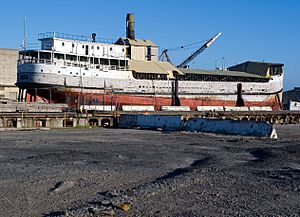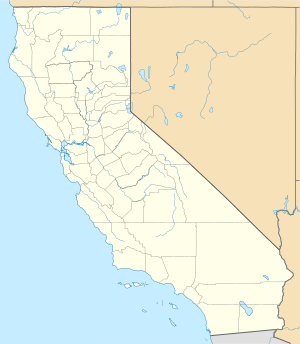Wapama (steam schooner) facts for kids

Steam schooner Wapama in Richmond Shipyard, February 2006
|
|
| History | |
|---|---|
| Name |
|
| Launched | 1915 |
| Fate | Dismantled in August 2013 |
| General characteristics | |
| Tonnage | 945 (gross), 524 (net) |
| Length | 216.91 ft (66.11 m) |
| Beam | 42.33 ft (12.90 m) |
| Depth | 19 ft (5.8 m) |
| Installed power | 825 hp (615 kW) triple-expansion steam engine |
| Capacity | 1,000,000 board feet (2,000 m3) of lumber |
|
Wapama (steam schooner)
|
|
 |
|
| Location | Richmond, California |
| Built | 1915 |
| Architect | James H. Price; St. Helens Shipbuilding Co. |
| NRHP reference No. | 73000228 |
| Significant dates | |
| Added to NRHP | 24 April 1973 |
| Designated NHL | 20 April 1984 |
| Delisted NHL | 27 February 2015 |
The Wapama, also called Tongass, was a special ship. It was the very last wooden steam schooner left. These ships carried lumber and other goods along the Pacific Coast of the United States. The Wapama was cared for by the National Park Service at San Francisco Maritime National Historical Park. Sadly, it was taken apart in August 2013.
In 1984, the Wapama was named a National Historic Landmark. This means it was a very important historical site. But this special title was removed in 2015.
Contents
Building the Wapama
The Wapama was a wooden schooner with two masts. It was about 217-foot-long (66 m) and 42-foot (13 m) wide. Its depth was 19-foot (5.8 m). The ship was built in 1915 by the St. Helens Shipbuilding Company in Columbia County, Oregon.
A master builder named James Price led a team of 85 to 100 workers. They launched the ship on January 20, 1915. At that time, it was mostly just a finished hull. The Wapama was then towed to San Francisco to be completed.
Workers installed the engine and built rooms for passengers and crew. The ship officially started working for the McCormick Lumber Company on April 29, 1915. It cost about $150,000 to build. The ship could carry 45 cabin passengers and 15 steerage passengers. It could also carry over one million board feet of lumber.
The Wapama's Working Life
The Wapama first belonged to the Charles R. McCormick Lumber Company. Over time, its ownership changed a few times. In 1915, it was sold to the Wapama Steamship Company. Later, in 1922, it went back to the McCormick Steamship Company.
The Wapama carried passengers and cargo between San Francisco and the Northwest. It would load lumber and people in the Northwest. Then it would return to San Francisco. Sometimes, it even towed other ships. The crew started with 31 people but was later reduced to 26.
In 1930, the ship was sold to the Los Angeles-San Francisco Navigation Company. It carried passengers and cargo between these two cities. You could even transport your car on it! In 1937, it was sold again to the Viking Steamship Company.
The ship was sold to the Alaska Transportation Company in 1937. On February 4, 1938, its name was changed to Tongass. The ship was updated to carry only cargo. It carried passengers, mail, and general cargo to Alaskan towns. It returned with frozen fish. The crew for these trips was usually about 30 men.
Accidents and End of Service
The Wapama had several accidents during its working life. In November 1915, it got stuck in silt in the Fraser River. It got stuck again in San Francisco in December. Luckily, there was no damage either time.
In May 1917, it crashed into another steamer called Doris. A month later, it got stuck in mud near San Diego. Again, no damage. The first serious accident was in December 1932. Its masts snapped while loading cargo.
Another accident caused "extensive damage" when it hit a breakwater in Long Beach. In May 1947, a crash in Seattle made its hull leak more. A Coast Guard check in June 1947 said the hull was okay. But the ship was taken out of service and sold for scrap in 1948. The last accident was a fire in the engine room in the 1950s.
Becoming a Museum Ship
In the 1950s, some people in California wanted to save important historical ships. They formed the San Francisco Maritime Museum. With state money, they bought the Tongass (the Wapama) in 1958 for $16,000.
Captain Adrian Raynaud oversaw the first repairs. The ship was put in drydock for two weeks. Workers removed old masts and cleaned the bottom. The hull was sealed and painted to help preserve it. This work made it safe to tow the ship to California.
From 1959 to 1963, the Oakland Dock and Warehouse Company restored the ship. They changed its name back to Wapama. The San Francisco Maritime State Historical Park opened to the public in October 1963. The Wapama opened as a museum ship a few days later.
Challenges and Final Years
Within a few years, the Wapama started to fall apart. In August 1969, a leak became very serious. Water was coming in at 600 gallons per hour. In strong winds, it was 1,000 gallons per hour. The ship's pumps could handle it at first. But two weeks later, the leak doubled to 2,000 gallons per hour. Divers found the leak and patched it up.
In 1972, the United States Congress created the Golden Gate National Recreation Area. The San Francisco Maritime State Historical Park became part of it. In 1977, California gave the park and its ships to the federal government. It became the San Francisco Maritime National Historical Park.
By 1979, the Wapama was in very bad shape. It needed major repairs to stay together. It was placed on top of a barge to keep it safe. In 1982, an expert named Maynard Bray checked the ship. He suggested covering it quickly to protect it. He thought a full restoration would take six to ten years.
In 1984, a plan was made for a $3.62 million restoration. This was supposed to happen from 1986 to 1989. Money was set aside for the restoration. A celebration marked its National Historic Landmark status. However, the restoration was delayed due to costs and staffing. A protective cover was built in December 1985 for $98,000. It was a partial roof over the front and main deck.
The End of the Wapama
The National Park Service announced in May 2011 that they planned to take the Wapama apart. They thought about saving its steam engine. Many people were sad about this news. Some wanted to save the ship, while others suggested burning it.
The Wapama's fate was similar to another lumber schooner, the Wawona. That ship was taken apart in 2009. However, not all old wooden ships are broken up. The lumber schooner C.A. Thayer, also cared for by the National Park Service, was restored. About 80% of its wood was replaced between 2004 and 2007. The whaler Charles W. Morgan also underwent a major restoration starting in 2009.
Why the Wapama Was Important
The Wapama was added to the National Register of Historic Places in 1973. It became a National Historic Landmark in 1984. It was important because it was the last wooden steam schooner. These ships were vital for the Pacific Coast lumber trade.
The Wapama could unload its own cargo. This was helpful because many ports were simple and did not have special equipment. Because of its poor condition, the Wapama was taken apart. The Historic American Engineering Record documented the ship as it was dismantled. This recorded how it was built.
Pieces of the Wapama, including its engine, will be saved. They will be used in a permanent exhibit at the San Francisco Maritime National Historical Park. The dismantling of the Wapama was finished in August 2013. Its National Historic Landmark title was removed in 2015.
Five other American wooden steamboats still exist. They are the Virginia V (1922), the Sabino (1908), Minnehaha (1906), Nenana (1933), and the ferry Eureka (1890). The Virginia V had a big restoration from 1995 to 2001.
Images for kids
- Historic American Engineering Record (HAER) No. CA-67, "Steam Schooner WAPAMA, Kaiser Shipyard No. 3 (Shoal Point), Richmond, Contra Costa County, CA", 90 photos, 30 measured drawings, 84 data pages, 7 photo caption pages



